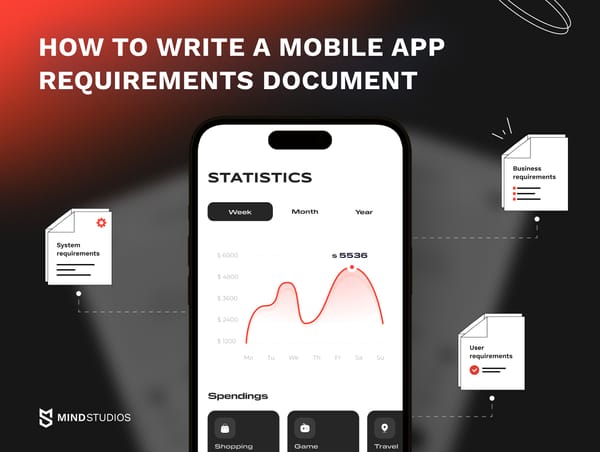Pharmacy owners and digital health entrepreneurs face unique challenges as they take on the responsibility of meeting personalized care demands and making pharmaceutical care more accessible to everyone. From navigating regulatory requirements to ensuring adequate medication counseling, building a successful digital pharmacy platform has become a complex journey. These challenges are magnified by the trend of providing a holistic approach to medication management, all while adapting to the rapidly evolving digital healthcare landscape.
In response to these pressing issues and as a software development company focusing on healthcare, we are invested in researching efficient digital pharmacy solutions as well. In this guide, we explore the online pharmacy trends defining the future of this rapidly evolving field, go over the challenges faced and the solutions forged in response, and review successful e-pharmacy products that exemplify the market's potential.
The modern digital pharmacy ecosystem
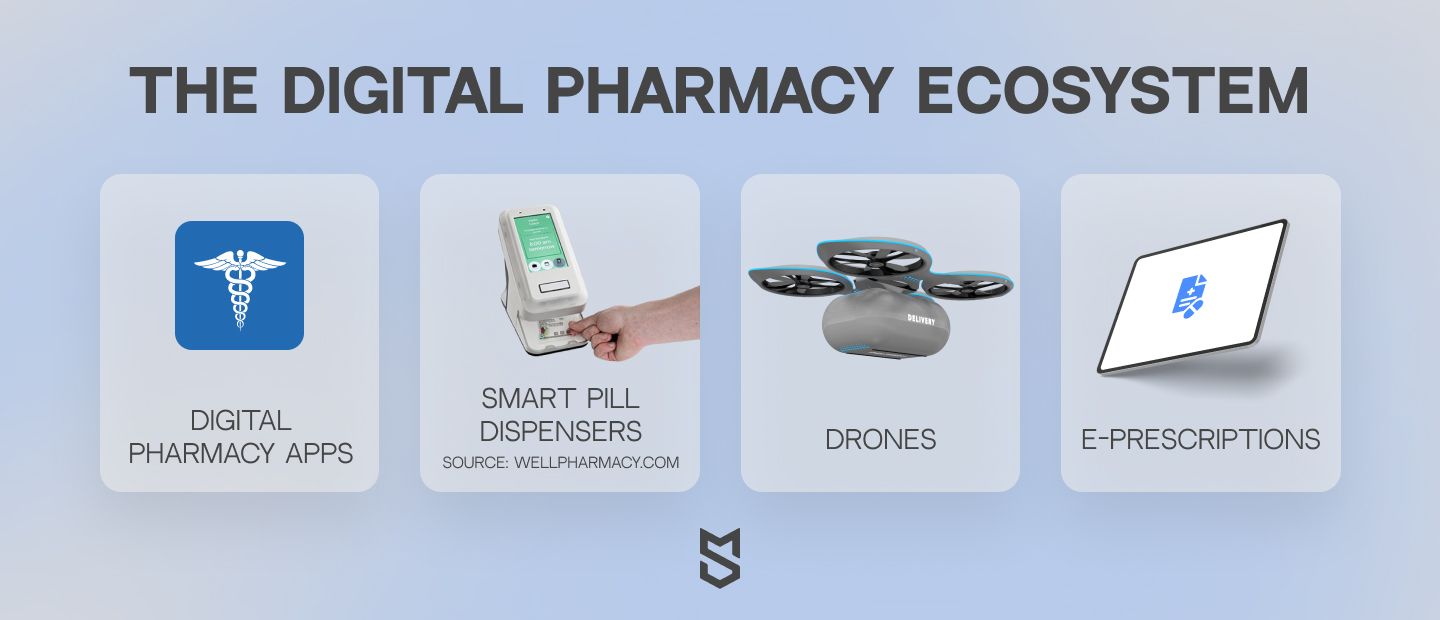
First things first, we need to determine what digital pharmacy entails. It refers to integrating digital technologies into pharmacy practice, encompassing services like online prescription management, telehealth consultations, electronic prescriptions, medication adherence tools, and direct-to-patient delivery of medications.
Digital pharmacy typically involves a combination of hardware and software technologies, each serving different functions within the pharmaceutical ecosystem.
Digital pharmacy ecosystem |
|
|---|---|
Software technologies |
Hardware technologies |
|
|
Current trends in digital pharmacy
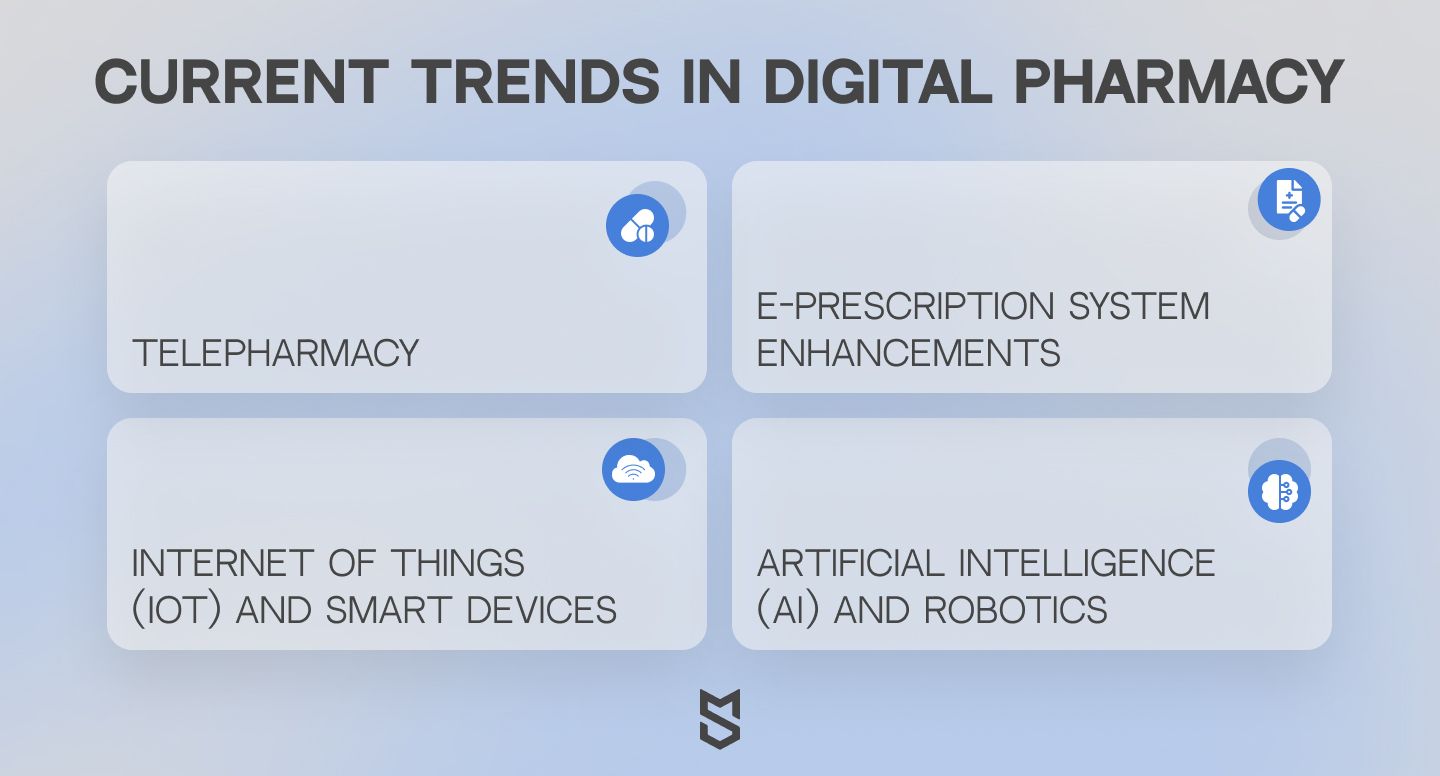
According to Dr. Dominique Ziegelmayer, CEO of DatamedIQ (a pharmaceutical mail-order data-based insights provider), the key trend in the digital pharmacy sector is ongoing digitalization. The expert notes that with a shift from traditional retail to mail-order services, consumers increasingly seek quick and efficient access to medications from home. This trend mirrors broader consumer behaviors, where the convenience of digital platforms for various goods has extended to include pharmacies, making "digital" one of the top trends in the pharmacy industry for 2024.
The question is, what does this digitalization entail? Here, we’ve gathered the most influential technological trends driving the field in 2024.
Telepharmacy
Telepharmacy has become the answer to a challenge of pharmacy deserts — areas with limited or no access to pharmaceutical care. Telepharmacies provide video conferencing and digital communication tools, allowing pharmacists to conduct remote consultations, provide medication therapy management, and offer clinical services without the need for patients to visit a physical location. Combined with medicine delivery, telepharmacy made pharmaceutical care more accessible for people in remote or underserved areas.
Companies like Capsule and PillPack have integrated telepharmacy services to streamline medication management and delivery, ensuring patients receive timely and personalized care. Telepharmacy platforms also incorporate features like medication synchronization and digital health assessments to improve patient outcomes. By allowing patients to discuss their medication regimen and health concerns in real time with a pharmacist, telepharmacy ensures a higher level of care continuity and support.
E-prescription system enhancements
While electronic prescriptions are not a new technology used in pharmacy, it is an evolving trend. E-prescription systems are becoming more sophisticated, offering seamless integration with electronic health records (EHRs) and pharmacy management systems. These advancements facilitate the instant transfer of prescriptions from healthcare providers to pharmacies, reducing errors, improving efficiency, and ensuring patient safety.
One of the biggest advantages of online prescriptions is fraud prevention. Since patient information is directly transmitted to the pharmacy, it minimizes the chances of altering details or tampering with prescriptions and using stolen prescription pads.
It’s also important to highlight the growing consumer demand for the convenience of e-prescriptions and home delivery that online pharmacies offer. The total number of e-prescriptions in the US in 2022 was over 2.3 billion. And a survey by DatamedIQ showed that 8 out of 10 Germans expressed their desire to repurchase prescriptions online. However, customers and healthcare providers both expect the process to get simpler and faster, so that’s something online pharmacists can work on in 2024.
Internet of Things (IoT) and smart devices
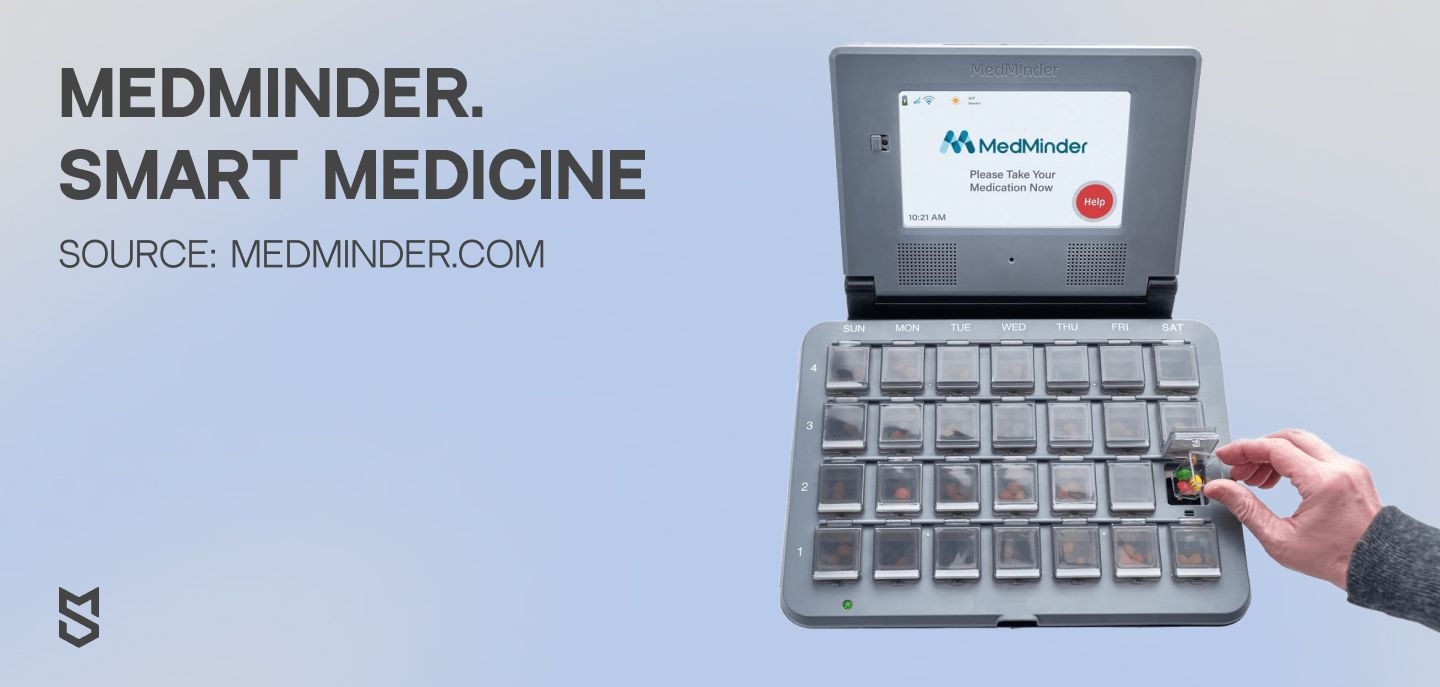
In digital pharmacies, IoT and smart devices are primarily used for remote patient monitoring and medication adherence. For instance, smart pill dispensers connected to digital pharmacy platforms can remind patients to take their medication, track doses taken, and alert healthcare providers in case of non-adherence. Products like Hero's smart dispenser and MedMinder's connected pillboxes are perfect examples of how the fusion of IoT technology and pharmacy can support independent living and efficient chronic disease management.
In addition to dispensers, wearable health monitors and IoT-enabled medical devices collect vital health data, offering pharmacists and healthcare providers real-time insights into patient health. This ongoing monitoring facilitates timely interventions and personalized medication adjustments, ultimately improving patient outcomes.
Artificial intelligence (AI) and robotics
While the first association between AI and the pharmaceutical industry often revolves around its role in drug discovery and ensuring drug safety, AI has also proved beneficial in digital pharmacies. Artificial intelligence and machine learning algorithms are used to personalize patient care, optimize inventory management, and predict medication adherence patterns. AI can also assist in identifying potential drug interactions and contraindications, enhancing patient safety.
According to the NCPA 2023 Digest, 24% of US pharmacies use robotics for compliance packaging, and the number is expected to grow in 2024. This shift not only promises to reduce wait times and increase accuracy but also allows pharmacists to dedicate more time to complex tasks.
Widespread adoption among independent pharmacies may evolve gradually. As these technologies gain traction, the industry must adapt to patients' changing needs and expectations, ensuring readiness for the advancement of these innovations.
Summing up, the evolving tech trends in digital pharmacy underscore the blend of software and hardware solutions powering this transformation. Mind Studios, with its expertise in healthcare software development, is ready to assist with the software component of digital solutions. Whether it's pharmacy app development, EHR integration, or other software solutions, our team has the expertise to implement your idea.
Digital pharmacy's impact on patient care
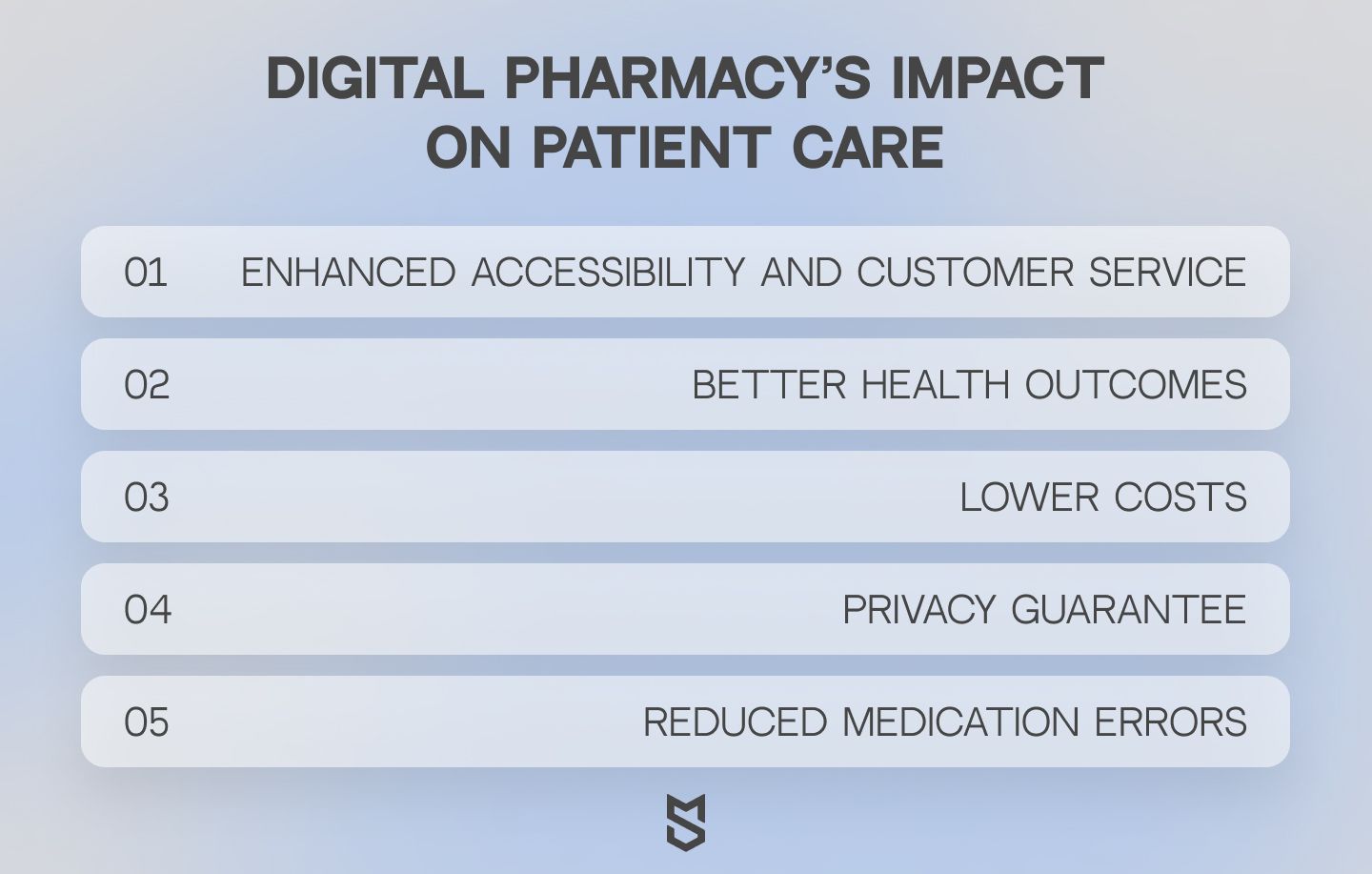
For pharmaceutical companies, a decision to develop an online pharmacy app means an opportunity to extend their reach. But how exactly does it affect patient care? Let’s find out.
Enhanced accessibility and customer service
As we’ve mentioned in the previous section, thanks to medication deliveries, digital pharmacies have enabled patients in remote or underserved areas to access pharmacy services regardless of their location. However, accessibility is not only about physical reach: digital pharmacies often extend their services to 24/7 support, chatbots, and teleconsultations. This helps patients manage prescriptions, obtain comprehensive medication information, and consult with pharmacists whenever needed. As a result, they feel more empowered to make informed decisions about their health.
Better health outcomes
Digital pharmacies facilitate personalization and improved medication adherence, and this directly translates into enhanced health outcomes. For instance, digital pharmacy platforms can analyze patient data to provide tailored medication recommendations, while reminders and tracking apps help patients follow their medication schedules accurately. The support digital platforms provide can assist users in managing chronic conditions more effectively, reducing the likelihood of hospital readmissions and enhancing patients' overall quality of life.
Lower costs
By streamlining the supply chain, reducing overheads, and optimizing inventory management, digital pharmacies can offer medications at more competitive prices. Additionally, the increased access to generic medications and the ability to easily compare prices across platforms also contribute to cost savings, making healthcare more affordable for a wider population.
According to a 2023 study by researchers at the University of Toledo College of Pharmacy, US patients could save significantly by purchasing their prescription medications via online pharmacy discount schemes rather than conventional insurance plans. To be more specific, at least 1 out of 5 prescriptions analyzed were cheaper through the Amazon or GoodRx discount card programs compared to the out-of-pocket expenses through traditional methods. The study estimated potential savings to be around $969 million for those using Amazon Pharmacy's discounts and approximately $1.83 billion for individuals using GoodRx's discount card programs.
Privacy guarantee
Trustworthy digital pharmacies prioritize data protection by employing advanced security measures to ensure patient privacy. With secure portals for prescription management and consultations, patients can trust that their health information is handled with the utmost confidentiality.
The commitment to privacy often extends beyond just data protection. Digital pharmacies typically offer discreet deliveries, where medications are shipped in unmarked packaging to maintain confidentiality and respect the sensitivity of patients' health needs. This approach to privacy not only safeguards patient information but also fosters a sense of trust in digital pharmacy services.
Reduced medication errors
Digital pharmacies typically use technologies like automated dispensing systems, e-prescriptions, and digital verification, all of which minimize the risk of medication errors, ensuring that patients receive the correct medications and dosages.
E-prescriptions, transmitted directly from the healthcare provider's system to the pharmacy, help avoid the pitfalls of handwritten prescriptions like misinterpretation, ensuring accuracy in the medication being dispensed. Additionally, digital verification processes employ barcode scanning and electronic databases to cross-check and validate prescriptions against patient records, thus safeguarding against discrepancies.
Challenges and solutions in digital pharmacy
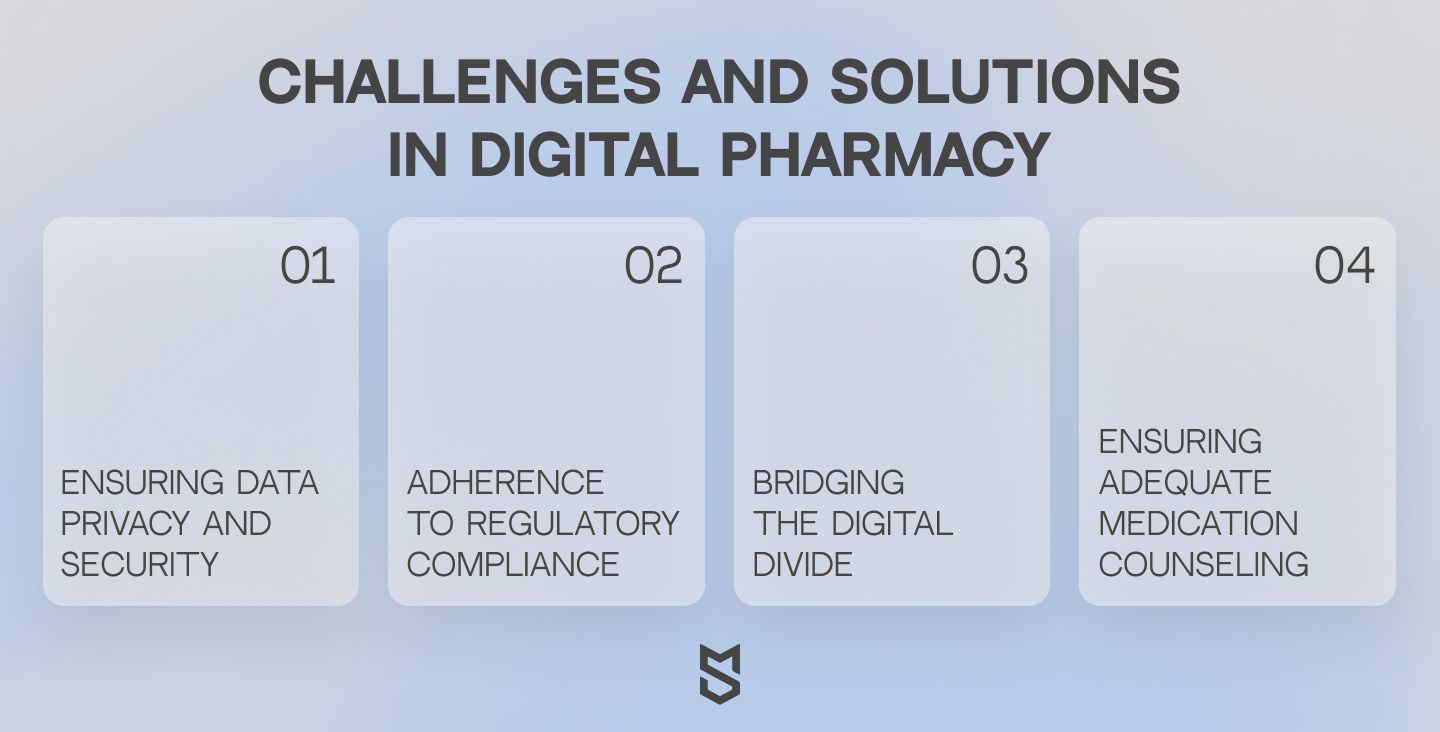
Adopting digital pharmacy solutions brings transformative benefits but also introduces a spectrum of challenges. Luckily, all of them have effective solutions which we offer in this section.
Ensuring data privacy and security
When it comes to healthcare, the safeguarding of sensitive patient data is a top priority. Yet, despite the implementation of data privacy and security guidelines, the risk of data breaches and privacy violations is still high. Healthcare organizations are the center of cyberattacks globally, with network and application attacks being the main type. In 2023, US-based healthcare organizations experienced 11 large data breaches of private health information, which affected more than 70.3 million individuals. Overall, there were 541 breaches reported.
As part of the healthcare ecosystem, digital pharmacies are also vulnerable to such events. The solution lies in security measures like:
- Robust encryption;
- Secure data storage;
- Stringent access controls;
- Regular security audits;
- Compliance with standards like HIPAA;
- Secure communication channels for e-prescriptions and patient consultations;
- Staff training on data privacy and security;
- Collaboration with a tech team with relevant experience, like a pharmacy app development company.
Adherence to regulatory compliance
Regulatory frameworks digital pharmacies must adhere to ensure that their clients get the same level of care, confidentiality, and quality as traditional pharmacies offer. This includes verifying prescriptions, safeguarding patient data, and ensuring the authenticity and proper handling of medications.
Regulatory compliance in pharma tech, including digital pharmacies, presents several significant challenges that companies must navigate through to ensure patient safety, maintain trust, and leverage tech advancements without facing consequences like financial penalties or reputational damage.
The pharmaceutical industry is subject to numerous regulations:
- Food and Drug Administration (FDA) controls pharmaceuticals in the U.S., setting standards for technology in clinical trials, data integrity, and digital health applications;
- Health Insurance Portability and Accountability Act (HIPAA) protects patient data privacy in the U.S., influencing how technology handles medical information;
- European Medicines Agency (EMA) provides guidelines for drug development and manufacturing, emphasizing technology use in the EU;
- General Data Protection Regulation (GDPR) affects pharmaceutical companies in the EU, dictating the management of personal data.
So, what’s the challenge of adhering to these regulations? The primary issue is connected to the interpretation of regulations, which are often written in a legalistic language and can lead to varied understandings and application inconsistencies. This can be especially problematic in areas like digital health, where the boundaries of regulated medical devices are not always clear. Furthermore, the rapid pace of technological innovation in the pharma sector often outstrips the evolution of regulatory frameworks, leaving companies struggling to remain compliant while adopting cutting-edge technologies like AI and machine learning.
Managing regulatory compliance in pharma tech is challenging but manageable with the following strategies:
- Staying updated on global regulatory changes to adapt compliance strategies proactively;
- Developing an integrated compliance framework that encompasses all business aspects for a comprehensive view of compliance and risk identification;
- Automating compliance processes for more accurate and efficient compliance in data management, reporting, and risk management;
- Training and educating employees to ensure they are instructed and regularly updated on regulatory responsibilities;
- Fostering a culture of compliance within the organization with leadership support and clear policies;
- Working with regulatory experts or outsourcing to navigate complex regulations.
Bridging the digital divide
Access to digital advancements is not uniform. Depending on geography, socioeconomic status, and tech literacy, people who need pharmacy services face disparities. People living in small rural towns can struggle to refill their prescriptions online due to limited internet access (or unfamiliarity with digital platforms, if we’re talking about population ages 65 and above). As a result, essential health products are not as accessible to them compared to urban dwellers and those who effortlessly manage their healthcare needs through a smartphone app.
So, what’s the solution? Pharmacies can provide a hybrid of digital and traditional services to ensure broad accessibility. For instance, this strategy can involve running an online platform for managing prescriptions and consultations alongside maintaining physical locations for in-person services. Moreover, pharmacies could educate patients on digital tools by offering in-store tech support.
Ensuring adequate medication counseling
One of the significant challenges digital pharmacies encounter is the absence of face-to-face interactions, which traditionally facilitated medication counseling and patient education. To address this issue and ensure patients receive the necessary medication guidance, digital pharmacies are innovating by offering electronic pharmacist consultations, educational medication videos, and accessible chat services.
Virtual platforms offered by digital pharmacies allow for personalized medication counseling, mimicking the comprehensive support traditionally available in physical pharmacies. By leveraging such technological solutions, digital pharmacies aim to provide patients with similar knowledge and guidance, mitigating the risks associated with inadequate medication counseling. Besides, personalized communication features can simulate human interaction, helping preserve the personal touch many patients need.
Case studies and success stories
When exploring the idea of building a digital pharmacy, it makes sense to draw inspiration from those who've already navigated these waters successfully and analyze established projects within the field to see what works. With this in mind, we've selected two prominent digital pharmacy companies that stand out in the market.
PillPack
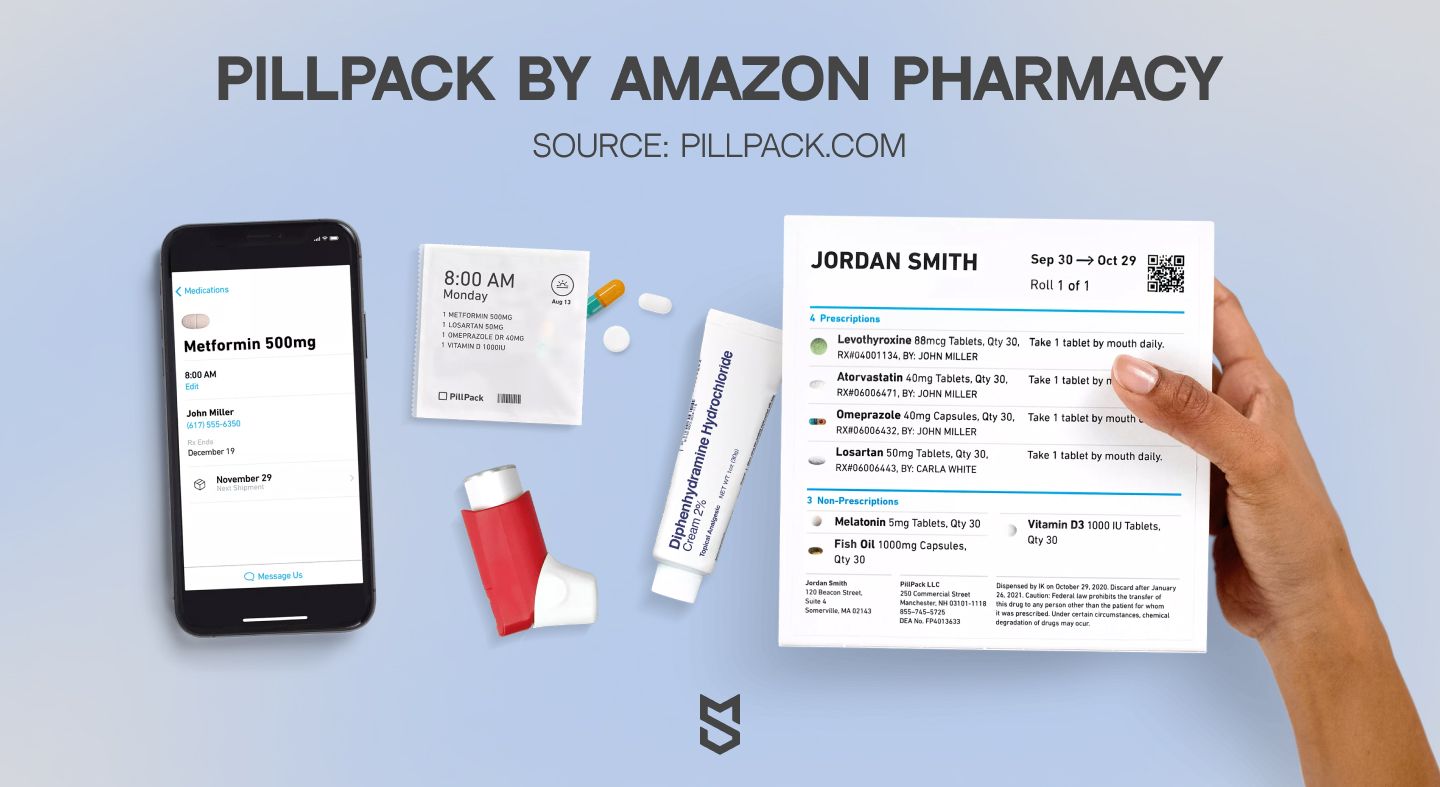
PillPack is an American online pharmacy that Amazon acquired. The service pre-sorts medications by dose and delivers them directly to the customer's door, thus simplifying medication management.
After the sign-up process, customers provide PillPack with their medication list and doctor's information. This way, the company’s pharmacists coordinate with the doctors to transfer prescriptions and verify medication schedules. The service is designed to handle everything from prescription renewals to dealing with insurance companies, removing the hassle often associated with traditional pharmacy experiences.
PillPack’s customers can manage their accounts online, track shipments, view their medication lists, and access 24/7 support from PillPack's pharmacy team. The deliveries come every month to the customer's doorstep in a discreet, recyclable dispenser box. The medications are pre-sorted into individual packets labeled with the date and time they should be taken, making it incredibly easy to adhere to medication schedules. This is especially helpful for customers who take multiple daily prescriptions.
Twentyeight Health
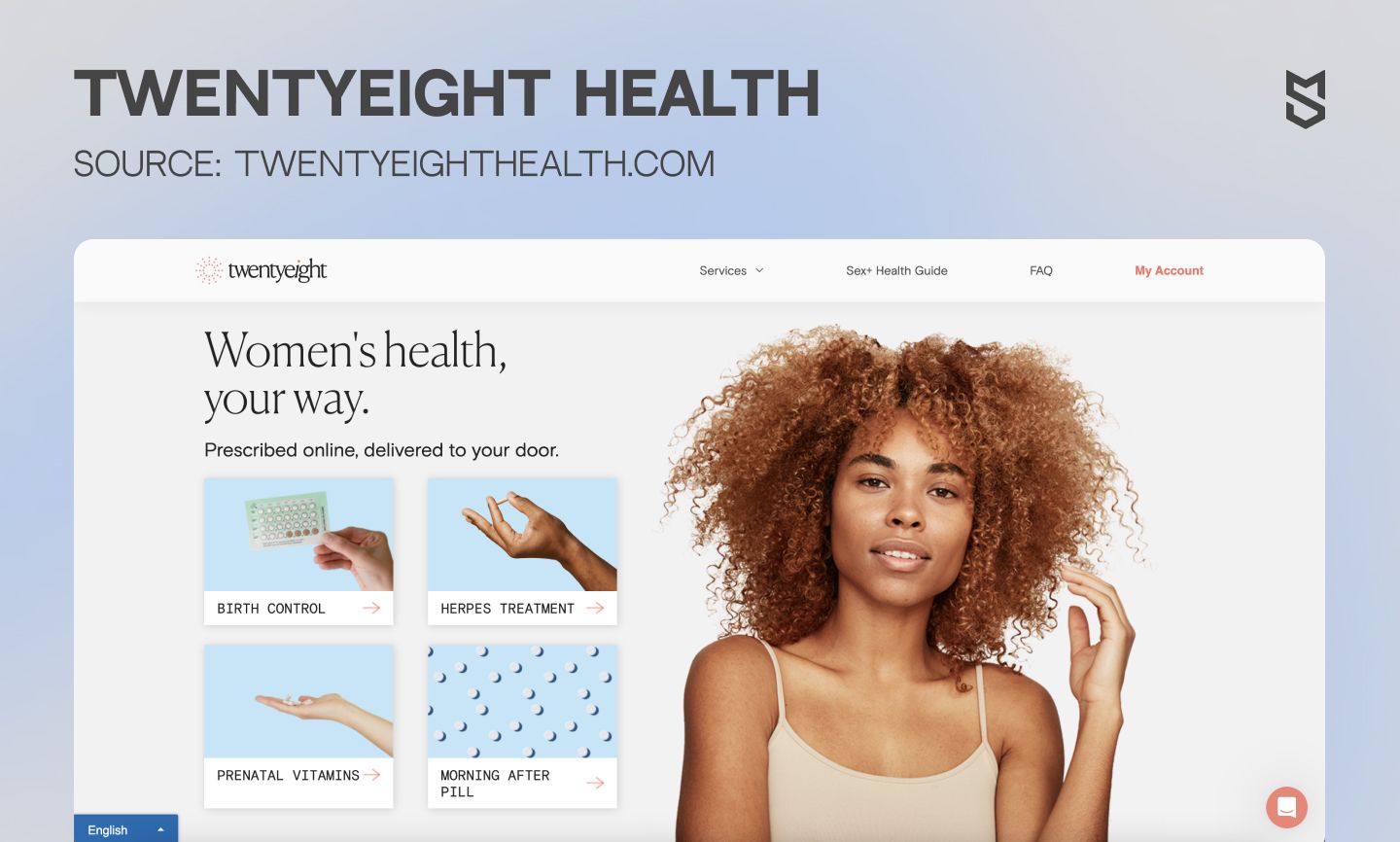
Twentyeight Health is not an ordinary digital pharmacy, but it’s essential for millions of women seeking reproductive health pharmaceuticals. The company actively addresses the challenge of "contraceptive deserts" in the United States, where over 19 million women of reproductive age lack sufficient access to a full range of birth control options. The company's mission is to provide affordable and convenient access to reproductive and sexual health services for underserved women, including those who are low-income, uninsured, living in rural areas, or facing barriers like limited internet access.
Women who want to use the service need to go through a quick online evaluation (for instance, through an online questionnaire or a free call). Then, the medicine is delivered in a discreet envelope in 3-5 business days. This initiative is particularly crucial in light of the closing of health clinics and the prevailing stigma surrounding contraception.
The company also extends its services beyond contraceptives, offering products like herpes treatment and prenatal vitamins, ensuring the information is accessible at a sixth-grade reading level in both English and Spanish. This approach, coupled with a network of culturally competent doctors and doctor-approved content, ensures that care is inclusive, overcoming barriers related to race, ethnicity, language, and education level.
Conclusion
The digital pharmacy market is experiencing rapid growth, driven by factors like increased internet usage, significant investments in pharmaceuticals, advancements in supply chain logistics, the development of digital payment infrastructures, and stringent drug sale regulations. As telehealth platforms make healthcare services more accessible and convenient for patients, digital pharmacies are becoming an integral part of the healthcare ecosystem, offering a promising venture for the foreseeable future.
At Mind Studios, we have experience in building healthcare software solutions that are not only innovative but also fully compliant with laws and regulations that govern the healthcare industry. Leveraging this expertise, we are well-equipped to take on e-pharmacy projects as well. If you're looking for tech expertise to navigate the complexities of online pharmacy app development, fill in a contact form for a free consultation.

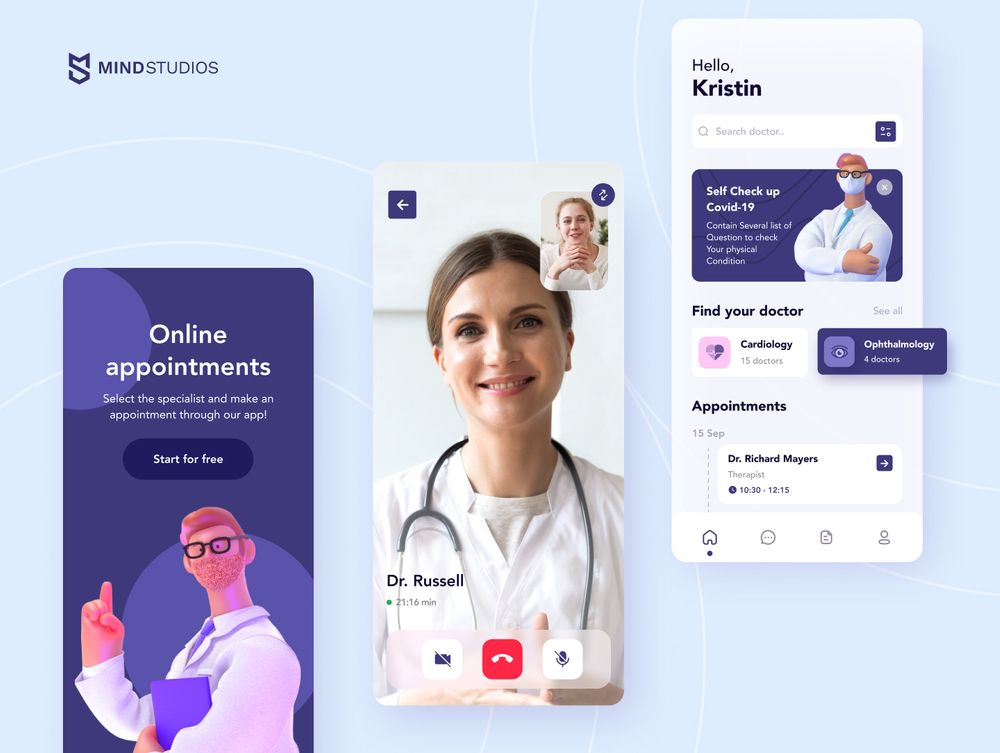
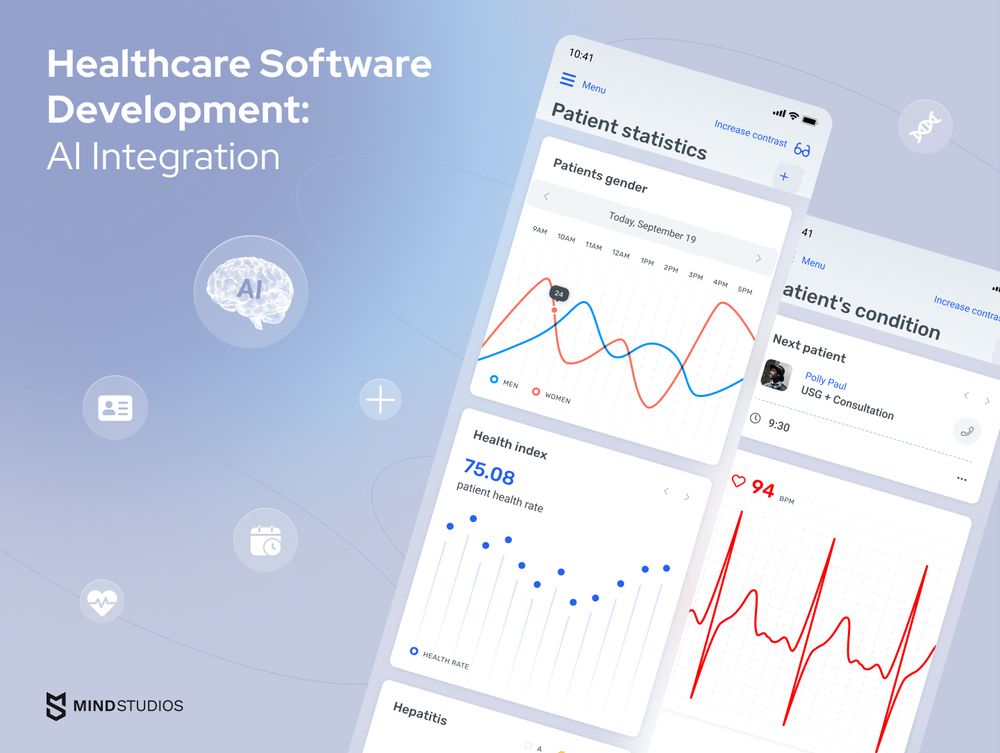


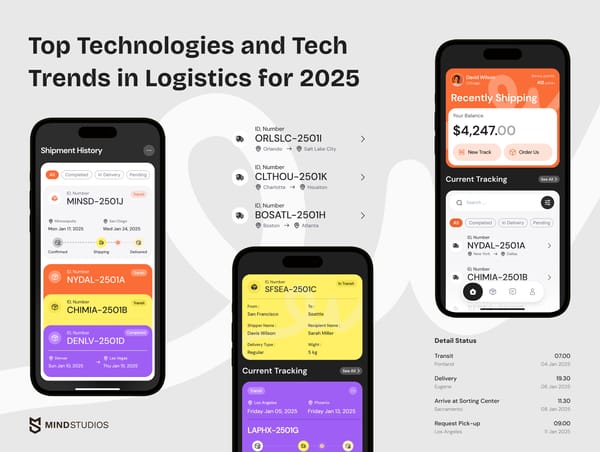

![How to Create an On-Demand Medicine Delivery App [Expert Guide]](https://themindstudios.com/blog/content/images/size/w600/2025/03/IMG-1-Cover-6.jpg)
